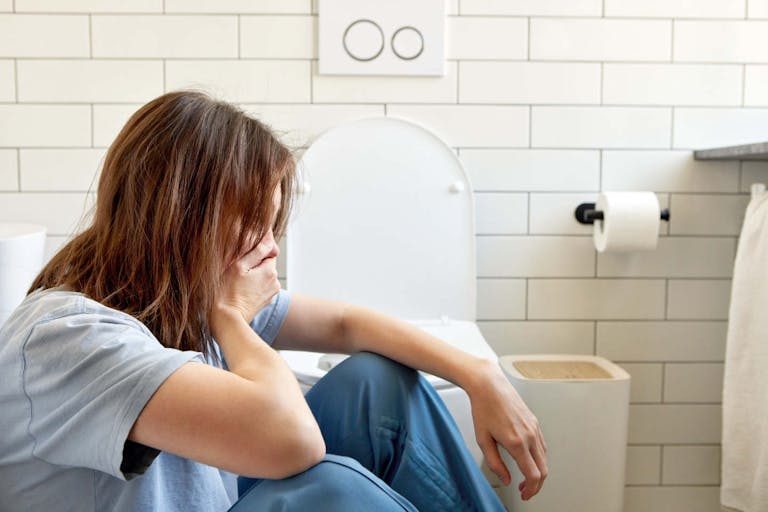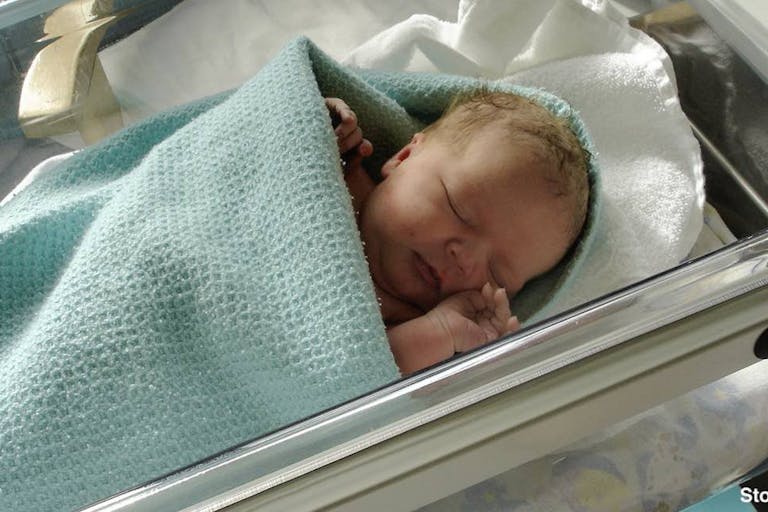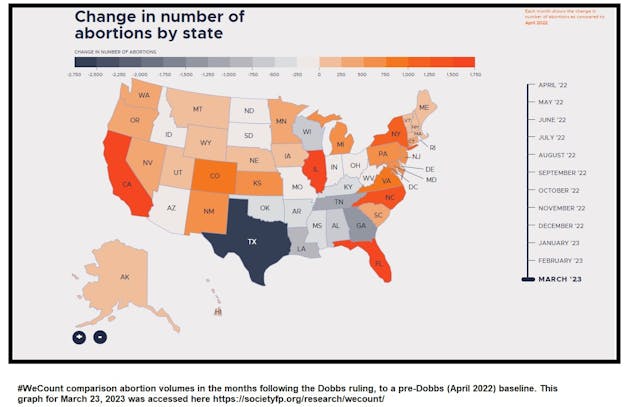
Welsh women denied needed pregnancy medication are getting abortions
Cassy Cooke
·
Pro-abortion research group claims abortions have dropped – but is this accurate?
A research project from the pro-abortion Society for Family Planning (SFP) known as #WeCount has estimated that over 25,000 fewer abortions took place from July 2022 through March 2023 — the nine months following the Dobbs v. Jackson Women’s Health Organization decision that overturned Roe v. Wade. But these numbers do not include a certain kind of abortion.
#WeCount also estimated that in “the nine months following the Dobbs decision, an average of 2,849 fewer abortions were provided in the US each month compared to April 2022,” just prior to the Supreme Court’s leaked decision.
The data was compiled from monthly abortion totals submitted to #WeCount by U.S. brick-and-mortar abortion facilities as well as virtual. Some estimates were calculated when reports were not sent back to #WeCount. The numbers were then analyzed by a steering committee made up of SFP and individuals from several universities and pro-abortion organizations. Those included Ibis Reproductive Health, Planned Parenthood, and Planned Parenthood’s former “special affiliate,” the Guttmacher Institute.
According to the data, the greatest decrease in abortions occurred in November of 2022, while the greatest increases occurred in March of 2023.

The good news is that enacted protections for preborn children are saving lives. But we must look at these numbers with caution.
“In the two months before Dobbs, the average monthly number of abortions provided by clinicians in the US was 81,730 while in the nine months after Dobbs, the average monthly number of abortions was 79,031,” #WeCount claimed. “Because Texas already had a six-week ban in place, this figure is an underestimate.”
“In the nine months following the Dobbs decision, an average of 2,849 fewer abortions were provided in the US each month compared to April 2022,” #WeCount researchers found, adding, “Abortion had been increasing in the US since 2017, and abortion rates were increasing in the months before the Dobbs decision. Thus, the net overall declines in abortion incidence in the US after Dobbs are even more striking given that need for abortion appeared to be increasing.”
The researchers noted, “Since the Dobbs decision, compared to the average monthly number of abortions observed in the pre-Dobbs period of April and May 2022, there were 25,640 cumulative fewer abortions from July 2022 to March 2023.”
States with near-total protections for preborn children have experienced the greatest reductions in numbers of abortions, the report claimed.
The report found that the number of states where the preborn were almost completely protected from abortion increased from nine states (Alabama, Arkansas, Mississippi, Missouri, Oklahoma, South Dakota, Texas, West Virginia, and Wisconsin) to 13 in the months between July 2022 and March 2023. The additional states included Kentucky and Louisiana (which #WeCount claimed banned abortion in August) and Idaho and Tennessee (which did so in September 2022). In July 2022, abortion was legal beyond six weeks in 39 states, but this number reportedly dropped to 36 by March 2023.
According to the report:
States that banned abortion saw 65,920 fewer clinician-provided abortions in the months since the Dobbs decision than would have been expected compared to April 2022.
States where abortion with six-week abortion bans were in effect saw a cumulative total of 15,720 fewer abortions provided by a clinician.
States where abortion remained legal with few restrictions increased from 79,280 abortions in April 2022 before the decision to 88,020 abortions in March 2023. States where abortion remained legal saw a cumulative total of 56,000 more people who had abortions in those states.
The difference between the cumulative decreases in states that restricted or banned abortion (65,920+15720= 81,640) and the cumulative increases (56,000) in states that did not restrict or ban abortion for those nine months (July 2022 – March 2023) equates to 25,640 fewer abortions from July 2022 through March 2023.
Abortion travel (some paid for by funding organizations and others by corporations) appears to have played a role in keeping overall abortion numbers high. And pro-lifers outside multiple abortion facilities in states that don’t protect the preborn have testified to seeing vehicles arriving from out of state.
“Our data suggests that many abortion seekers living in states with bans may have traveled to other nearby states for care, and that increases are seen in states close to states with bans, even if those receiving states had abortion restrictions such as mandated in-person counseling and waiting periods,” the report noted.
According to the report, “States with the largest increases in the total number of abortions provided by a clinician during the nine-month period after Dobbs … include Florida (12,460), Illinois (12,400), North Carolina (7,930), Colorado (4,500) California (4,260),” #WeCount wrote.
“States with the largest declines in the number of abortions during the nine-month period after the Dobbs decision compared to baseline include Texas (23,340), Georgia (15,720), and Tennessee (10,100),” the report stated.
U.S. abortion data has been fairly consistent since 1973, but with the proliferation of unregulated and potentially dangerous virtual abortion pill businesses such as Aid Access and others( including illegal abortion pill syndicates smuggling or dispersing abortion drugs across the U.S. border from Mexico), it is important to look at these numbers honestly and recognize that some of the decreases could be an overestimate. The reason? It is not possible to count all sales and use of abortion-inducing drugs in the U.S.
Article continues below
Dear Reader,
In 2026, Live Action is heading straight where the battle is fiercest: college campuses.
We have a bold initiative to establish 100 Live Action campus chapters within the next year, and your partnership will make it a success!
Your support today will help train and equip young leaders, bring Live Action’s educational content into academic environments, host on-campus events and debates, and empower students to challenge the pro-abortion status quo with truth and compassion.
Invest in pro-life grassroots outreach and cultural formation with your DOUBLED year-end gift!
The #WeCount researchers noted this when they wrote:
This report does not reflect any self-managed abortions, defined as any attempt to end a pregnancy outside the formal healthcare system, including using medications, herbs or something else, or obtaining pills from friends or online without clinical assistance.
Aid Access founder Rebecca Gomperts claimed in a July 2022 interview that after Texas restricted abortion, the international abortion pill group saw an 1100% increase in requests for abortion pills from the state.
In addition, during November of 2022 (when #WeCount found that abortions decreased the greatest), a study published by JAMA Network claimed that Aid Access had “received 42,259 requests from 30 states” post-Dobbs.
In February of 2023, a separate study noted:
With the proliferation of information-sharing on the Internet in particular, more people have been ordering medication abortion pills from online sources to end pregnancies on their own, a process referred to as self-managed medication abortion… In their first 2 years of operation, Aid Access received 57,506 requests for medication and demand for this service has surged as state-level abortion restrictions have been enacted.
While the #WeCount report noted uncounted abortions, researchers clarified that “it is unknown how many of these requests were fulfilled, how many were received, or how many were actually taken….” #WeCount added that “totals of pills requested, while a critical signal of interest in abortion, are not the same as the number of abortions that occurred and should not be combined with the total number of abortions reported via #WeCount.”

While the data suggests that banning abortion does save preborn lives, it also reveals the need to protect the preborn in every state.
“In the nine months after Dobbs, in states that had bans, an estimated 65,920 fewer people [66K] obtained abortions. This translates to, in the nine months following the Dobbs decision, an average of 7,324 fewer people per month who were able to obtain abortions in states with bans, as compared to April 2022,” the report claimed.
“Even nine months after the Court’s decision, increases in numbers of abortions in states where abortion was permitted did not compensate for the reductions seen in states where abortion was banned,” #WeCount’s data showed.
However, as stated above, the difference between the cumulative decreases in states that restricted or banned abortion (65,920+15720= 81,640) and the cumulative increases (56,000) in states that did not restrict or ban abortion tragically reduces that 66K number down to an estimated 25,640 fewer total abortions from July 2022 through March 2023.
But as the post-Dobbs months roll on, the average reduction in abortions appears to be shrinking.
In April, Live Action News documented that “there were 32,260 fewer abortions in the six months following Dobbs (July to December of 2022) when compared to the average monthly number of abortion in the preceding period,” according to #WeCount [emphasis added]. This translated into an average of 5,377 fewer abortions each month.
But months later, #WeCount data reveals that the monthly average decreases had dropped by 47%, from an average of 5,377 fewer abortions each month (six months post-Dobbs) to an average of 2,849 fewer abortions (nine months post-Dobbs).
While it is likely that — as many places pass protections for preborn children — women will make lifestyle changes or seek other means to keep from becoming pregnant. And pro-lifers must continue to assist women experiencing unplanned pregnancies and work even harder until we protect every preborn child in every state of the nation.
Live Action News is pro-life news and commentary from a pro-life perspective.
Contact editor@liveaction.org for questions, corrections, or if you are seeking permission to reprint any Live Action News content.
Guest Articles: To submit a guest article to Live Action News, email editor@liveaction.org with an attached Word document of 800-1000 words. Please also attach any photos relevant to your submission if applicable. If your submission is accepted for publication, you will be notified within three weeks. Guest articles are not compensated (see our Open License Agreement). Thank you for your interest in Live Action News!

Cassy Cooke
·
Analysis
Cassy Cooke
·
Analysis
Angeline Tan
·
Analysis
Cassy Cooke
·
Politics
Madison Evans
·
Opinion
Nancy Flanders
·
Abortion Pill
Carole Novielli
·
Investigative
Carole Novielli
·
Human Rights
Carole Novielli
·
Abortion Pill
Carole Novielli
·
Investigative
Carole Novielli
·